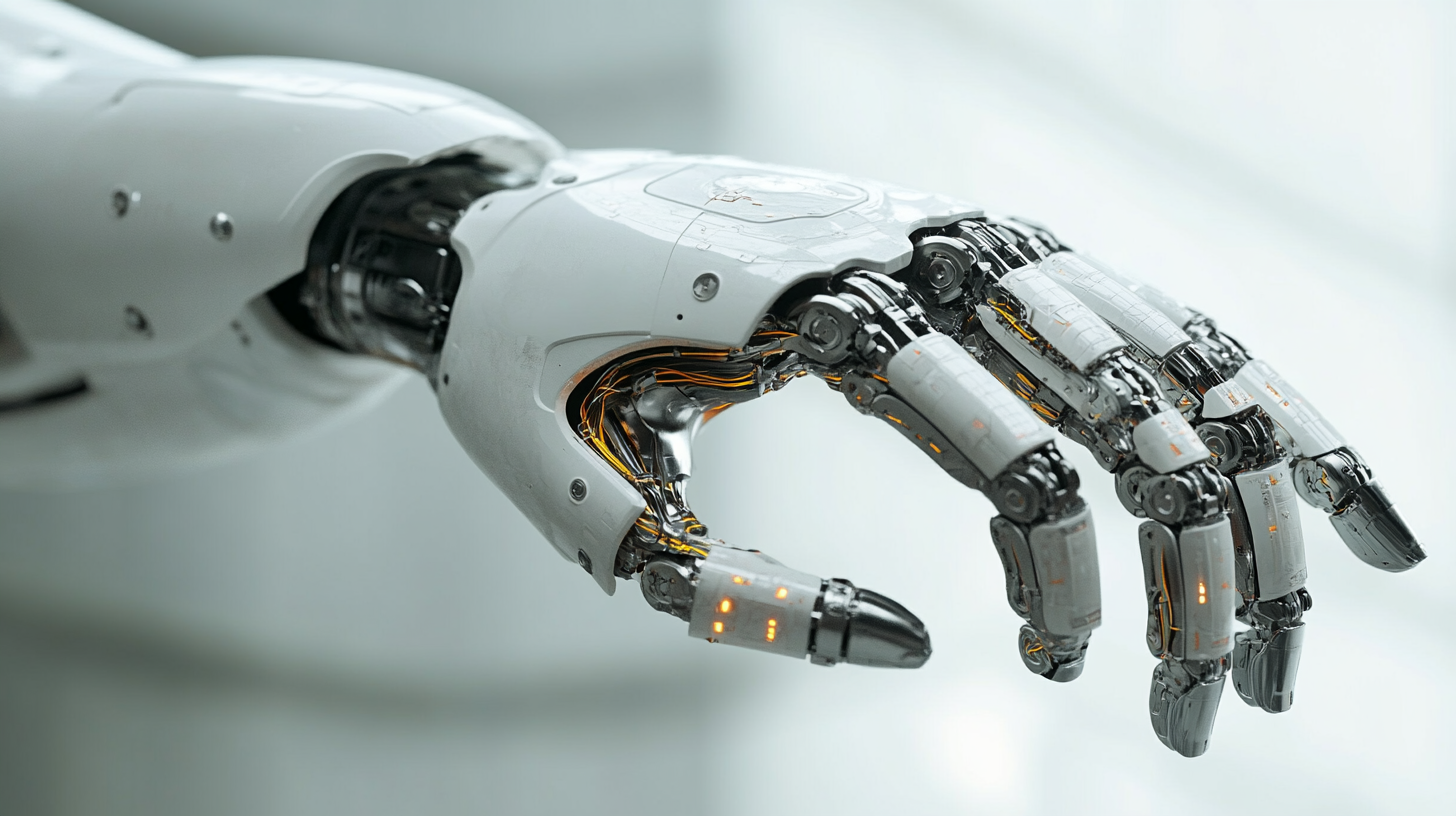Use it to plan your own robot barista payback period.

Want to know more details?
Please, contact your manager.
Aleksandr Maksimovich
Business Development Manager
Nalarobot Robotics | Nalarobot Café
Mobile: +375 333 760 460
(WhatsApp | Telegram | Viber)
BLOG
Navigating the Future of Robotic Machining in Global Supply Chains for 2025
In the rapidly evolving landscape of manufacturing, the integration of robotics has emerged as a crucial element in optimizing production processes. Recent data from the International Federation of Robotics indicates that the global market for robotic machining is projected to grow at a compound annual growth rate (CAGR) of 12% between 2020 and 2025. This surge is driven by advancements in automation technology, which are enabling companies to enhance efficiency, precision, and scalability within their supply chains. As manufacturers face growing pressure to improve productivity and reduce costs, Robotic Machining is stepping up as a transformative solution across various industries.
Looking ahead to 2025, the implications of widespread adoption of Robotic Machining are significant. According to a report by Statista, approximately 75% of businesses in the manufacturing sector are expected to implement robotic systems to stay competitive, optimizing not only their machining processes but also improving overall operational agility. This blog will explore the critical role of robotic machining in global supply chains, examining how it addresses the challenges of flexibility and responsiveness in an increasingly complex marketplace. As we navigate this future, understanding the technological innovations and strategic implementations of Robotic Machining will be vital for industry stakeholders aiming to thrive in a competitive environment.

Emerging Trends in Robotic Machining Technology for 2025
As we approach 2025, robotic machining technology is poised for transformative growth, influenced by emerging trends that bolster its role in global supply chains. The proliferation of collaborative robots, driven by their low capital requirement and user-friendly programming, is expected to redefine manufacturing environments. Reports indicate that collaborative robots will see significant market expansion, thanks to their ability to work alongside human operators, enhancing productivity and efficiency. This human-machine synergy allows organizations to leverage advanced automation without the necessity of complex training programs, thus accelerating their return on investment. The integration of artificial intelligence and machine learning into robotic machining processes is another pivotal trend for 2025. These advancements not only facilitate better decision-making but also optimize operational performance through the use of digital twins and predictive analytics. Industry forecasts suggest that AI-driven robotics will enhance mobile manipulation capabilities, enabling robots to adapt to various tasks and environments with minimal human intervention. This adaptability is crucial as supply chains become more dynamic and responsive to changing market demands. Moreover, as highlighted in several industry reports, robotics is set to penetrate new applications beyond traditional manufacturing. From logistics to precision machining, the versatility of robotic systems will empower businesses to explore innovative solutions that drive efficiency and reduce costs. As organizations navigate the complexities of modern supply chains, the ability to adopt and integrate emerging robotic technologies will be a decisive factor in maintaining competitive advantage in the coming years.

Impact of Global Supply Chain Dynamics on Robotic Machining Adoption
The integration of robotic machining in global supply chains is increasingly influenced by the dynamics of those very supply chains. According to a recent report by McKinsey & Company, the global robotics market is projected to grow to $100 billion by 2025, with a significant portion attributed to advancements in robotic machining technologies. As manufacturers seek to enhance productivity and efficiency amidst fluctuating market demands, the adoption of robotic machining solutions becomes essential.
Moreover, a survey conducted by Deloitte indicates that over 60% of manufacturers are leveraging automation to address supply chain disruptions. This trend highlights a critical shift in the industry's approach to production—moving from traditional machinery to more flexible, automated systems. With robotic machining, companies can not only minimize operational costs but also enhance their responsiveness to global market shifts, creating a more resilient supply chain framework.
As countries emerge from the pandemic and geopolitical tensions reshape trade relationships, robotic machining offers a pathway for manufacturers to maintain competitive advantage. A report by the International Federation of Robotics estimates that the proliferation of robotics could lead to a 20-30% reduction in labor costs and improved product quality. These factors are crucial as businesses navigate potential supply chain bottlenecks, driving the need for innovative automation solutions that can adapt to changing demands and improve overall efficiency.

Key Benefits of Integrating Robotics into Manufacturing Processes
The integration of robotics into manufacturing processes is set to revolutionize global supply chains by 2025. One of the key benefits of this technological shift is the significant enhancement in productivity. A recent report from McKinsey & Company indicates that companies deploying robotic machining can improve their operational efficiency by up to 30%. This increase in productivity is primarily due to robots' ability to operate continuously, minimizing downtime and enabling manufacturers to meet demand without compromising quality.
Moreover, the use of robotics in machining processes leads to greater precision and consistency. According to a study by the International Federation of Robotics (IFR), industrial robots achieve a reduction in error rates by up to 90% compared to manual operations. This level of accuracy is crucial in sectors like aerospace and automotive, where precision machining is critical to safety and performance. By incorporating robotic technology, manufacturers can ensure that their products meet stringent quality standards, thus enhancing their market competitiveness.
Cost reduction is another significant advantage of robotic integration. A report from Deloitte suggests that organizations can save between 20% to 40% in production costs through automation. These savings stem from decreased labor expenses and minimized material waste, as robots optimize cutting and machining processes. As manufacturers look to streamline operations amidst rising economic pressures, the implementation of robotics in machining will be a pivotal strategy for sustaining profitability while navigating the complexities of the global supply chain.

Challenges and Solutions for Implementing Robotic Machining Systems
As we look towards 2025, the implementation of robotic machining systems within global supply chains faces unique challenges that manufacturers must strategically navigate. One of the primary obstacles involves the integration of robotic systems into existing manufacturing workflows. Many small-to-mid-sized manufacturers struggle with limited budgets and a workforce that may not be sufficiently skilled in advanced robotics technologies. To overcome these hurdles, the adoption of collaborative robots, known as cobots, can provide a solution. These robots are designed to work alongside human operators, enhancing safety and efficiency, while allowing companies to scale automation effectively without significant upfront investment.
Another critical challenge lies in ensuring precision and productivity while minimizing disruption during the transition to robotic machining systems. Companies can leverage advanced vision systems that incorporate real-time hazard detection to enhance workplace safety. This implementation enables robots to operate alongside workers seamlessly, reducing the risks associated with automated environments. Moreover, technological collaboration between robots and machine tools allows for agile production processes, helping manufacturers maintain a competitive edge in an ever-evolving market landscape.
In addition, the concept of Robotics-as-a-Service (RaaS) offers manufacturers a flexible approach to scaling their robotic solutions. By enabling companies to access robotic technology on a subscription basis, RaaS allows them to experiment with various applications without the burden of hefty capital expenditures. This paradigm shift not only democratizes access to cutting-edge technology but also supports an iterative process where businesses can adapt their robotic routines based on real-time performance data and production needs.
Future Skills and Workforce Development in Robotic Machining Industries
As the landscape of robotic machining continues to evolve, the significance of future skills and workforce development in this field cannot be overstated. With advancements in machine learning, artificial intelligence, and robotics, the demands on the workforce are shifting rapidly. Professionals in robotic machining will need to adapt by acquiring new competencies that align with the industry's trajectory toward automation and precision.
To prepare for the future, educational institutions and training programs must pivot to focus on interdisciplinary skills that blend engineering, coding, and robotics. Hands-on experience with cutting-edge technologies will be essential, as well as understanding the complexities of integrating robotic systems into existing supply chains. Partnerships between industry leaders and educational organizations can facilitate internships and apprenticeships, providing students with real-world experiences that sharpen their skills.
Moreover, as robotic machining becomes increasingly prevalent across global supply chains, soft skills such as problem-solving, collaboration, and adaptability will also play a critical role. The ability to work in diverse teams and communicate effectively across various platforms will enhance a workforce's resilience to changes brought about by technological advancements. Emphasizing a culture of continuous learning will ensure that workers are not only equipped with the technical knowledge needed today but also prepared to evolve alongside the industry in the years to come.

